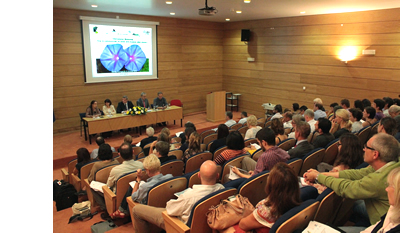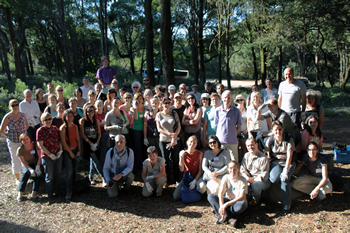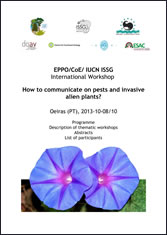
EPPO/CoE/IUCN ISSG International Workshop
How to communicate on pests and invasive alien plants?
Oeiras (PT), 2013-10-08/10

A joint EPPO/CoE/IUCN ISSG Workshop took place on 2013-10-08/10 in Oeiras in Portugal at the kind invitation of the Direcção-Geral de Alimentação e Veterinária (Portuguese Plant Protection Organization), the Centre for Functional Ecology (University of Coimbra) and the Agrarian School of Coimbra (Instituto Politécnico de Coimbra). The workshop was aimed at civil servants, scientists, land managers, members of NGOs, journalists, and any other interested persons. It was attended by 65 participants from 25 countries (Australia, Belgium, Czech Republic, Denmark, Finland, France, Germany, India, Israel, Italy, Jersey, Netherlands, Netherlands, Portugal, Kenya, Russian Federation, Slovenia, South Africa, Spain, Sweden, Switzerland, Turkey, Ukraine, United Kingdom, United States).
Pictures were kindly provided
by Alexandre Gamela (PT) - www.invasoras.pt
Why organizing a workshop on communication on pests and invasive alien plants?
Governments, Universities and NGOs are undertaking research on pests and invasive alien plants which have agricultural or environmental impacts and taking action to try to prevent the introduction and spread of these species or to control them. Despite this wealth of initiatives, stakeholders and the general public are rarely aware of what pests and invasive alien plants are and of the damage they cause. Raising the level of awareness of the civil society is an indispensable step for political decisions and legislation to be taken.
Communicating on the topic of pests and invasive alien plants is difficult as it involves explaining what an alien species is, as well as describing their impacts. Scientists and civil servants working on these species are usually not trained in the use of communication tools and methods. Gathering examples of different communication tools and why some of these worked well and others did not and exploring the concepts underlying the perception that people have of these species would be valuable for those drafting guidelines on how to best communicate on pests and invasive alien plants.
Conclusions the Workshop
The 3-day Workshop was divided into two and a half days of presentations and discussions. At the end of the Workshop, participants drafted the conclusions of the Workshop which can be viewed below. Half a day was dedicated to the Portuguese 'Invasive Plants Clean Up Day' during which participants helped in containing the invasive tree Acacia longifolia in the 'Parque Natural de Sintra-Cascais (Serra de Sintra, Peninha)'.
The participants of the EPPO/CoE/IUCN-ISSG/DGAV/UC/ESAC Workshop are aware that pests, including invasive alien plants, are a major cause of damage to crops, health concerns and biodiversity loss. In order to contribute to the implementation of Aichi target 9 of the Convention on Biological Diversity and the International Plant Protection Convention (IPPC), they agreed on the following conclusions concerning communication on pests and invasive alien plants:
- As biological invasions are intrinsically linked to human behaviour, communication is an essential component of policy and measures dealing with this issue;
- It is essential to improve co-operation and to share information in between all sectors, in particular the plant health sector and environment sectors;
- It is necessary to strengthen communication on the damage caused by pests - including invasive alien plants – particularly in urban areas, which are home to most of the European population, and which can facilitate the identification of potential strategic partners to work with (e.g. municipalities, botanic gardens, etc.) when developing information campaigns and other outreach activities;
- There is a clear need to improve communication in the field of biological invasions and it is particularly important and urgent to explore all the facets of the issue and to develop a more interdisciplinary approach based on the involvement of social sciences (i.e. communication science, sociology, anthropology, etc.) in this field;
- Effective communication requires: the definition of target audience, objectives, clear messages and the tools to be used, and evaluation of the outcomes; it is important to involve professional staff with adequate skills and to take into account existing experiences around the world;
- When addressing mass media (both formal media and the many varied web-based instruments) messages should be adapted for non-specialist audiences, avoiding technical and complex language, and giving preference to ‘stories’ and other elements (visual and other) that make the message attractive;
- Improving communication requires capacity building and training in the relevant disciplines and tools;
- Communication efforts need to be carefully planned, form an integral part of programmes and projects aimed at preventing entry, containment or eradication of pests and invasive alien plants and receive long-term funding; results of communication and awareness efforts need to be carefully evaluated to assess their impact on public perceptions and behaviour;
- An international, web-based platform to share experiences on communication on pests including invasive alien plants would be a much welcomed step in the efforts to improve methods and achieve a better public understanding on the impacts of pests including invasive alien plants on nature, crops, health and livelihoods; such a platform should be able to help publicising interesting experiences and allow research on public attitudes on the topic.
Presentations
Session 1: How international institutions communicate on pests and invasive alien plants?
EPPO activities on communication on pests including invasive alien plants
Anne-Sophie Roy and Sarah Brunel, European and Mediterranean Plant Protection Organization (EPPO)
Bern Convention activities: voluntary Codes of conduct for botanic gardens and horticulture and engagement with the public
Vernon Heywood, School of Biological Sciences, University of Reading
Asia-Pacific Forest Invasive Species Network (APFISN): Accomplishments made on raising awareness on invasive species
Kavileveettil Sankaran, Kerala Forest Research Institute, India
Seven years’ experience in Plant Health at the European Food Safety Authority (EFSA)
Sara Tramontini and Olaf Mosbach-Schulz, European Food Safety Authority
The European Environment Agency work with IAS: from expert reports to citizen science
Paco Sánchez-Aguado, European Environment Agency
International trade and invasive alien species
Kenza Le Mentec, Standard and Trade Development Facilities, World Trade Organization (WTO)
IUCN/ISSG communication activities on alien species
Riccardo Scalera, IUCN Invasive Species Specialist group
Session 2: Difficulties in communicating on pests and invasive alien plants: the need for interdisciplinarity
Coping with pests and invasive alien species: the actors, their categorizations and the communication issue
Frank Alvarez-Pereyre, Centre national de la recherche scientifique, France
Mimosa freak show - A presentation on the acacia propaganda (and anti-propaganda) in Portugal
Manuel Fernandes, Centro de Estudios de Geografia e Ordenamento do Território, Faculdade de Letras, Universidade do Porto, Portugal
Communication on IAS issues to media
José Manuel Fernandez
Developing your message: five points to consider
Jamie Reaser, Congruence, LLC, USA
Needs and barriers to effective IAS communication in the developing world
Arne Witt, CABI
Different media for different audiences in a diverse society
Alex Marsh, South African National Biodiversity Institute, South Africa
Session 3: Experiences that worked, experiences that did not work
Forest Invaders – the outcomes of a project about invasive species inside and outside the classroom
Hélia Marchante, Universidade de Coimbra, Escola Superior Agrária/Instituto Politécnico de Coimbra, Portugal
Examples of communication on pests by the German plant protection organization
Katrin Kaminski, Julius Kuehn-Institute (JKI), Germany
Experience from two awareness raising projects on alien species in Slovenia
Jana Kus Veenvliet, Institute Symbiosis, Slovenia
The importance of field-work projects on increasing public awareness about invasive species: a case study in Portugal
Maria Morais, Universidade de Coimbra, Portugal
Invasive species management coordination in the Loire catchment area
Stéphanie Hudin, Fédération des conservatoires d'espaces naturels, France
Communication: the fastest growing part of the management of plant invasions in Saxony-Anhalt, Germany
Katrin Schneider, Centre for Invasive Plants in protected areas of Saxony-Anhalt at UfU, Germany
Use of complementary tools to optimize awareness
Céline Fontaine, Centre Permanent d'Initiatives pour l'Environnement du Val d'Authie, France
Japanese knotweed, journalism and Joe Public
Dick Shaw, Regional Coordinator for Invasive Species, CABI
Session 4: Adapting the message to different stakeholders and citizen sciences
The Code of conduct on invasive plants in Belgium: results after two years of communication with the horticultural sector
Mathieu Halford, Biodiversity & Landscape Unit, University of Liège Gembloux Agro-Bio Tech, Belgium
Working with the horticulture industry to limit invasion risks: the Swiss experience
Franziska Humair, Institute for Environmental Decisions – Consumer Behavior, ETH Zurich, Switzerland
Do code-of-conducts increase public awareness and engagement in problems with invasive aquatic plants?
Laura Verbrugge, Radboud University Nijmegen, Institute for Science, Innovation and Society, Department of Philosophy and Science Studies, Nijmegen, the Netherlands
Israel's least wanted alien ornamental plant species - The IL-LWAOPS is, at this stage, a proposed list of alien taxa which should not be planted in Israel.
Jean-Marc Dufour-Dror, Consultant to the Israel Nature & Parks Authority, Israel
New elements in the monitoring of invasive alien plants in the Czech Republic
Martina Sojneková, State Phytosanitary Administration, Czech Republic
Public awareness: a useful tool for the early detection and a successful eradication of the Longhorned Beetles
Mariangela Ciampitti, Italian Plant Protection Organization, Italy
video 1 and video2 ![]()
Warning network for detection of new invasive alien species in Reunion Island
Catherine Julliot, Direction de l'Environnement, de l'Aménagement et du Logement de La Réunion, France
Mapping invasive plants in Portugal: involving the public and promoting awareness
Elizabete Marchante, Universidade de Coimbra, Portugal


